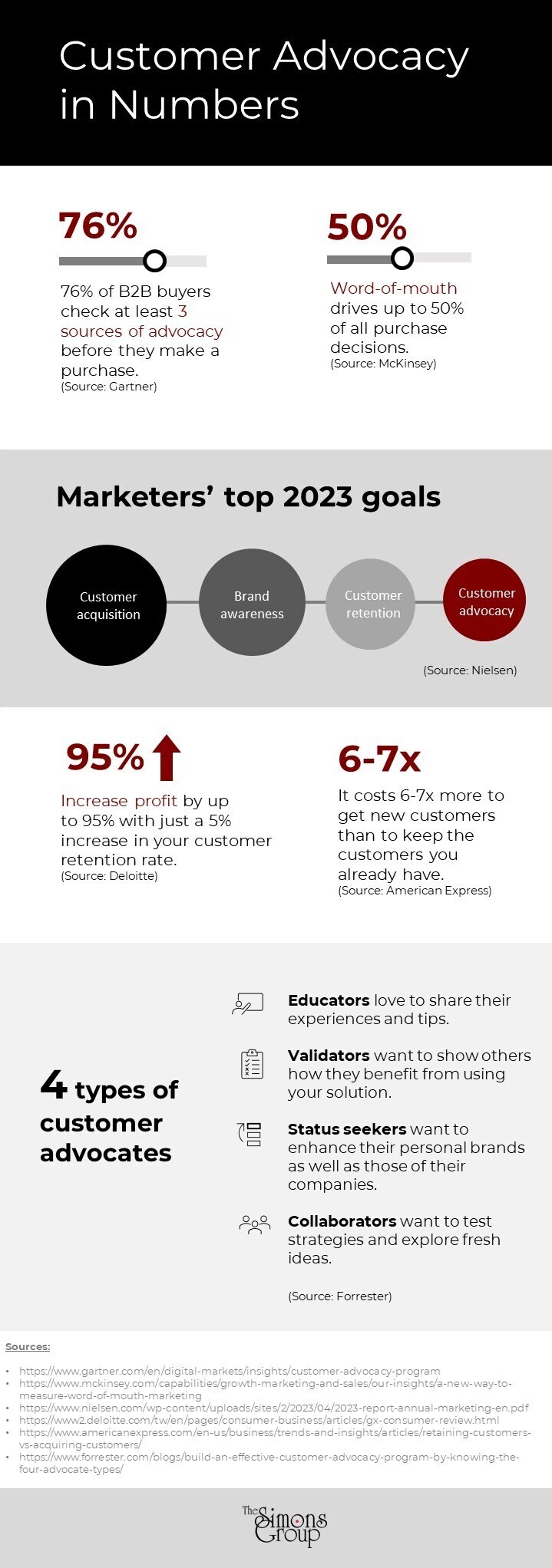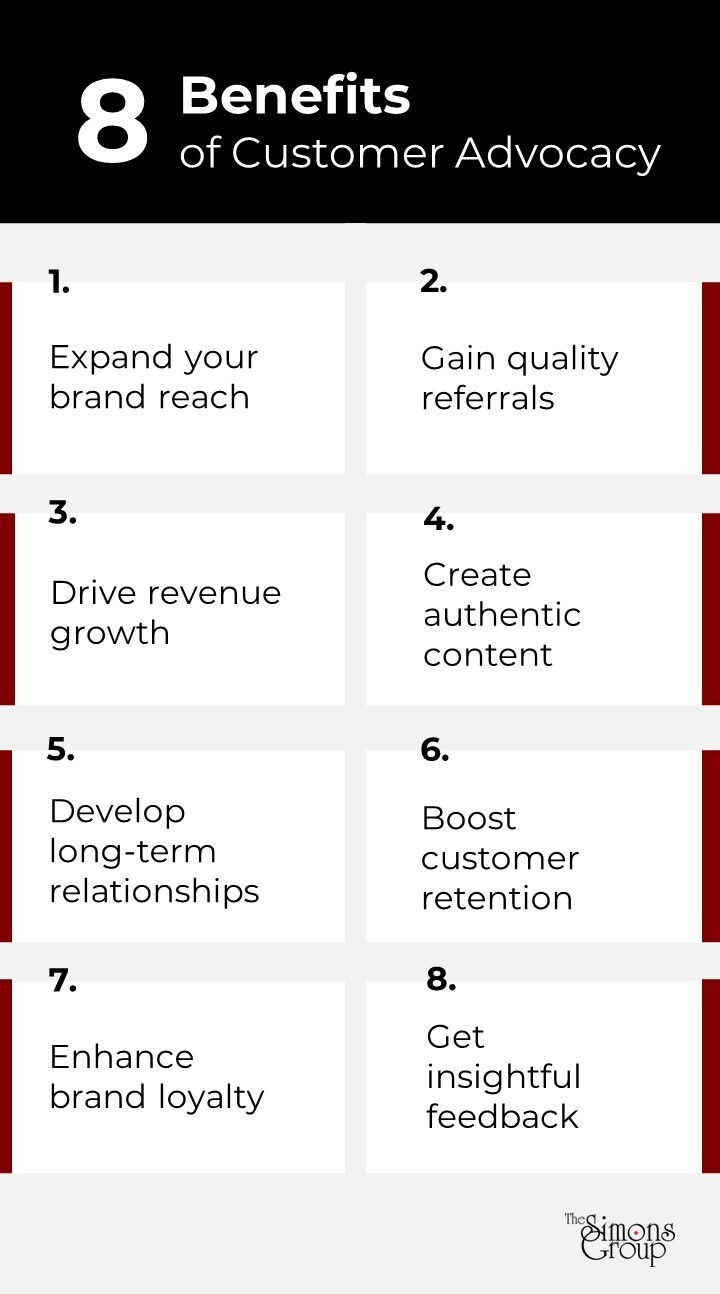If your brand wants an unbeatable advantage that will boost your sales, marketing and customer experience, build a strong customer advocacy program. Every brand – no matter how big or small – will benefit from having advocates.
What is customer advocacy?
Customer advocacy is about building authentic, strong relationships with loyal customers and nurturing them to become brand champions. As advocates, they’ll share their positive experiences with your business. They’ll also help promote your products and services to prospective customers.
Think of advocates as an extension of your organization who promote their successful outcomes to your prospects. Their contributions are as influential and important as those of your sales and marketing teams. Your prospects want to know how customers like them have benefited from your products and services.
When they’re shopping for solutions, prospects pay close attention to your customers’ experiences and feedback. Having customers explain why they chose your brand gives you a big competitive advantage. These endorsements are much more powerful than standard promotional content.
“Advocacy programs encourage current buyers to spread the word about your business to their social circles, which may boost your company’s visibility and, ultimately, your sales,” said Vladimir Fomenko, director and founder of Infatica, a global proxy provider.
What are advocacy programs?
Advocacy programs are promotional opportunities that your customers participate in. Examples include:
- Referrals
- Sales references
- Video and written testimonials
- Product reviews
- Case studies
- Content contribution
- Social sharing
- Roundtable events
- Webinars
- Speaking engagements
- Online customer communities
- Customer advisory boards
Enterprise organizations can have formal programs with several promotional opportunities for hundreds of advocates. In contrast, small businesses may start with less-intensive referrals, sales references and written testimonials. The mix often depends on internal resources. Full-time customer advocate specialists often manage the programs at large companies. A small organization may have one person in marketing who’s responsible for brand advocacy.
Are customer advocates right for my business?
When I began interviewing subject experts for this article, several companies that I contacted were interested in starting advocacy programs but hadn’t yet. Overwhelmingly, those that responded and have formal programs are cloud software companies. These include Hootsuite, Wrike and Sendoso.
But I also interviewed leaders at other organizations and customer advocacy pros who have years of experience developing and managing advocacy programs. Here’s their consensus: If you have customers – and you wouldn’t be in business if you didn’t – an advocacy program is right for your company.
What are the benefits of customer advocacy?
Advocates feel more engaged with your brand and are invested in your company’s success. As a result, they help drive demand for your products and services organically. Embracing advocacy also helps with retention and churn prevention.
Buyers are overwhelmed with marketing messages today, so they want to hear what your customers are saying about your products and services. When your customers endorse your brand through testimonials, case studies, reviews, customer communities and other programs, buyers pay close attention. That’s because prospects trust your customers’ feedback more so than first-party-generated marketing.
As more marketers rely on generative artificial intelligence to create branded content, customer advocates’ input will become more important than ever, said Joe Kevens, a brand advocacy expert at B2B SaaS Reviews and director of demand generation at PartnerStack, a partner and affiliate management program.
“There’s going to be even more of a need for customer advocacy in marketing to harness that human voice,” Kevens said. “The voice of the customer will help communicate value.”
How many advocates do I need?
Don’t be dissuaded from starting a program with a handful of advocates. You can start small and build on your successes. In short, there’s no magic number.
“Think quality over quantity,” said Karilla Dyer, customer references manager at Wrike, a cloud project management software company. “I’d rather have fewer advocates who are highly engaged than hundreds of advocates who aren’t engaged.”
Scott K. Wilder, head of Digital Success at Clari, a revenue operations platform, has created and managed customer advocacy programs at companies including HubSpot and Marketo. He agreed that the number of advocates doesn’t drive success.
“I’ve seen companies with five advocates and others with a thousand,” he said. “It’s not a numbers game. It’s about their value, what they can contribute to a company and how they support others like them in the market.”
How do I identify the best advocates for my program?
To identify possible advocates, coordinate your efforts with other departments, such as marketing, sales and customer support. Work with these teams to segment customers according to their levels of engagement and what you’ll ask them to do for you. Advocacy experts recommend focusing on those customers who are contributing the most to your business and the customer community. But that doesn’t mean you should limit the field to those who spend the most. Lower-tier customers may also have a lot to offer.
“Sometimes, you can get people who are up-and-coming,” said Thierry Chau, vice president of Market Development at CommScope, a global telecommunications company. “They may have a lot to contribute in terms of technical or go-to-market knowledge.”
Wilder agreed that expanding your scope beyond elite customers can reap rewards.
“The rising stars at the second tier, for example, are key because they could become your future tier-one advocates,” he said.
Leslie Barrett, director of Customer Marketing and Advocacy at Sendoso, a gift-sending platform that supports business-to-business sales and account-based marketing, has multiple strategies for selecting advocates.
“I use Gong to listen for people who love Sendoso, and then I ask them to join our program,” she said. “I also target big accounts who are using our platform a lot. I’ll send them a direct email with an ask and a QR code to join.”
In addition, she creates a “smart list” from Marketo for those who are opening the company’s emails. Recipients who have the highest engagement can be ideal advocates. For example, customers who opened nine of your 10 most recent email newsletters are prime candidates for your advocacy program.
Similarly, customers who take the time to share positive feedback on social platforms, support channels or email can become advocates.
Another strategy for finding potential brand champions is to look at your company’s net promoter score (NPS). This score measures how likely your customers would recommend your business to their friends or colleagues. A high NPS is considered a leading indicator for strong customer advocacy.
Should I offer incentives for my advocates?
Successful customer advocacy hinges on mutually beneficial relationships. Vocal promotion raises brands’ profiles and contributes to their sales and marketing wins. In turn, brand ambassadors appreciate getting something in return. That doesn’t mean free vacations, lavish gifts and other expensive perks. Generally, the advocacy pros I interviewed cautioned against quid pro quo arrangements. The issue is that you want to have authentic relationships with your customers that are based on trust and value rather than the gifts they might get.
“There’s certainly a reciprocal relationship, but you don’t want it to become transactional,” Kevens said. “When customers see the relationship as purely transactional, they check out.”
Hope Kerby, who oversees global customer advocacy at Hootsuite, a social media management platform, welcomes incentives on a limited basis.
“I think it depends on the customer and what you’re asking,” she said. “A lot of our customers are really happy to be involved because we’ve already established good relationships with them.”
Wrike’s Dyer agreed.
“I find that the strongest advocates don’t expect that much,” she said. “The ones who want to get paid to play aren’t typically as enthusiastic. Those who genuinely love our product and want to see us be successful don’t expect things in return.
“And we don’t want to be accused of trying to influence the sentiment of a conversation,” she added. “That’s why I’m not big on giving too many incentives.”
Incentives can include:
- Public recognition
- Private recognition
- Exclusive content
- Invitations to online customer communities
- Collaboration on product upgrades or new products
- Loyalty programs
- Nominal gift cards
- Branded swag
“Some customers love a bit of the limelight, so we celebrate them and recognize their successes,” Kerby said. “We position them as thought leaders and innovators in their industries through the promotion of their customer stories via social, email or media pitches.”
Regardless of which incentives you might choose, keep in mind that customers in regulated industries can’t accept gifts. To show her appreciation for them, Barrett might offer things like front-row seats at Sendoso conferences or opportunities to meet one-on-one with the company’s product team.
How much can I ask advocates to do?
It’s great to embrace advocacy, but be sure to avoid customer burnout. Multiple touches from different departments and company representatives can make advocates feel like they’re being bombarded.
“I want to know what our customers are doing and what we’re asking of them,” Dyer said. “I don’t want to ask for a reference call this week if the marketing team asked the customer to participate in a speaking opportunity last week.”
How much or how little you ask advocates to do will vary based on several factors, including:
- Who will add the most value for your program
- The amount of time they can spend on advocacy activities
- Their enthusiasm for your products and services
- How influential they are for prospects
- Their strengths and weaknesses. For example, an advocate who’s a weak public speaker might provide a powerful testimonial or an impressive case study interview.
“You have to be respectful of people’s time and capacity, and always give them the opportunity to say ‘no,’” Dyer said. “Reassure them that you’ll still love them if they decline.”
Clari’s Wilder recommends checking with advocates about their activities quarterly, every six months or annually to be sure you’re not asking for too much.
Do the hard work for your advocates
Make it as easy as possible for your advocates by explaining the process and steps for each activity upfront and the time they’ll require. A case study, for example, might require three to five hours of a customer’s time, including the interview, content review and approval process. At a minimum, your customer will want to know:
- Who will lead the project and manage reviews and approvals
- How the interview will be conducted
- Who will participate in the interview
- Whether you’ll identify the customer by name
- Where the case study will appear and who will have access to it
Be respectful of your customers’ time, recognizing that advocacy activities aren’t their highest priorities. Similarly, help your customers advocate for your brand successfully by providing the resources they’ll need well in advance. For a case study, you’d want to provide one to three previous case studies from your business, a topic outline and the interview questions.
“I always tell our customers, ‘We’re going to do the heavy lifting for you,’” Wrike’s Dyer said. “That means we’re going to help them with the presentation; we’re going to write the case study; and we’re going to do as much of the work as possible. Never put the onus on the customer.”
How can I measure customer advocacy performance?
Determining return on investment (ROI) for customer advocacy can be tricky. For example, what’s the value of an advocate praising your organization on social media? Or what’s the return on positive G2 reviews for your software?
One of the things you can do is to review closed/won deals that included customer referral and reference activity, Dyer said. She uses this approach to demonstrate the amount of revenue that she influenced.
At Hootsuite, Kerby collaborates with the company’s sales team to identify how much influence advocacy activities, such as case studies, have and tie them to closed deals.
“It’s a percentage,” she said. “We’re working to pinpoint what that percentage is.”
Wilder acknowledged the difficulty of tying advocacy programs to revenue.
“It’s never a straight attribution, as in Beth read this particular customer success story and then bought our product,” he said. “But you can say it’s inferred.”
CallerSmart, a caller ID app, measures success by the number of conversions or sign-up rates, said Brian Crane, the company’s founder.
“You can do a lot of market surveys and research, but you’re lost if you don’t know how to use data to make critical decisions,” he said. “Data on sign-ups or the number of referrals collected can help you analyze the value of these programs from a marketing budget standpoint.”
Dyer noted that customer advocacy isn’t solely about generating new business and revenue. The focus is on keeping customers happy and engaged.
“Look at your customer retention rates,” she said. “Advocacy improves account longevity and strong customer relationships.”
For those who are struggling to quantify their programs’ performance, Barrett offers a 45-minute course that explains how to calculate advocacy ROI using a data-driven approach.
What can advocates do for me and my marketing?
Here are a few examples of what advocates can do for you and how they can support your marketing. They can:
- Give shout-outs for your company and engage with prospects on social media
- Contribute video or written testimonials that you can share on your website, in campaigns, via social media and in pitch decks
- Share their experiences in written case studies that you promote on your website, in campaigns and via social media
- Participate in question-and-answer sessions in webinars, online customer communities, “lunch-and-learns,” user group events and industry conferences
- Answer prospective customers’ questions in one-on-one reference calls and webinars
- Serve on customer advisory boards that help shape product development and strategic business decisions
Barrett recommends that you “double down” on the most effective approach and innovate to spin off new creative tactics. She engineers and tests new strategies that will keep the momentum going for advocates and Sendoso’s marketing.
Bonus: Expert tips
Customer advocacy experts shared tips for running successful advocacy programs based on their experiences:
- Start small. Introduce one or two advocacy programs. Build on your successes when you gain traction.
- Gamify engagement with contests. Assign points for advocacy activities to build enthusiasm. Advocates who earn the most points can qualify for badges, incentives and rewards.
- Anticipate advocate turnover. It doesn’t mean they don’t love your brand anymore. Your champions may need to assume other responsibilities that require their attention and time.
- Collect advocate feedback. Use it to create a resource center with helpful articles, webinars and video tutorials.
- Make customer introductions. Customers don’t want to talk with vendors. Instead, they want to talk with other customers and learn from them. Make sure your advocacy program facilitates those connections.
- Acknowledge advocates’ successes. Celebrate them publicly. They appreciate recognition because it boosts their profiles.
Customer advocacy is a win-win
Customer advocates promote your brand and share their positive experiences with others. Those endorsements are golden, especially in business-to-business (B2B) marketing. B2B prospects want to know how others like them have benefited from your products and services. When they see positive experiences and strong outcomes, your brand will stand out in a crowded market.
“The future is customer-led growth and priming your customers from the beginning to be on the road to advocacy,” Barrett said.





